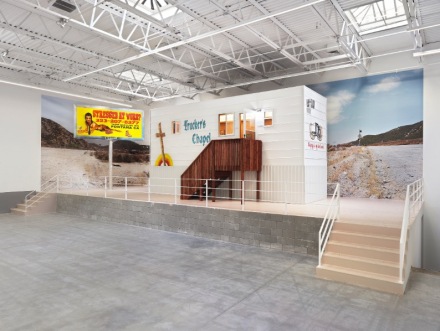
Mario Ayala, Truck Stop (Installation View), via Jeffrey Deitch
On view this month at Jeffrey Deitch Gallery in New York, artist Mario Ayala brings Southern California’s Inland Empire to bear on the East Coast, ruminating and celebrating the landscape of California with a series of paintings and sculptures, including a truck stop chapel, tire shop and roadside billboard installed in the gallery to create the context for his new work. Ayala’s meticulously crafted paintings extend the American Pop tradition into the present, drawing on a unique combination of art historical and vernacular influences shaped through his own life experience.
Ayala’s work is referred to as “working class paintings,” by the gallery, an attempt to connect and reflect the lived experience of truck drivers and automobile mechanics with whom he grew up, as much as regular gallery-goers, a body of works that blend together easily accessible imageries and languages with a dense and nuanced understanding of the progression of modern painting and the image. Ayala describes his work as fusing Cool School and Mission School, drawing on the language of artists inspired by LA billboards, the streets of California, and the sprawling metropolises of the state. Yet the artist’s work extends beyond these signifiers, equally embracing broader traditions of pop art, Latin art, and the traditions of community-based art practices (zines, posters, and other modes of independent publishing).

Mario Ayala, Truck Stop (Installation View), via Jeffrey Deitch
Ayala sees a parallel in the East Los Angeles subculture of lowriders and the hot rod culture that inspired the Cool School artists. He draws on both to create his distinctive combination of fine art and popular art imagery. Many of the paintings feature words, adding his contribution to the history of Los Angeles artists incorporating text into their paintings. The structure of the paintings also builds on Minimalism. He channels Donald Judd in his stack of precisely painted stereo consoles from automobile dashboards, which also reference Ashley Bickerton’s incorporation of commercial logos. The paintings, by contrast, combine details and elements from digital and industrial methods as much as they draw on classic modes of portraiture and still-life painting.

Mario Ayala, Truck Stop (Installation View), via Jeffrey Deitch

Mario Ayala, Truck Stop (Installation View), via Jeffrey Deitch
After art school, Ayala studied automobile painting at LA Trade Tech and continues to study industrial painting processes. His combination of industrial applications with a practiced artist’s hand gives his work a unique sensibility. He compares the layering of glazes in old master and automobile painting, explaining how both use this technique to achieve realistic effects and an illusion of wetness. The works, images of the backs of actual trucks, buses, an ambulance, oil cans and billboards, present an elaborate portrait of personalities and psychologies, layered portraits of the driver and the modern era by the compounded details.
The artist’s work is on view through October 29th.
– D. Creahan
Read more:
Mario Ayala: Truck Stop [Exhibition Site]



